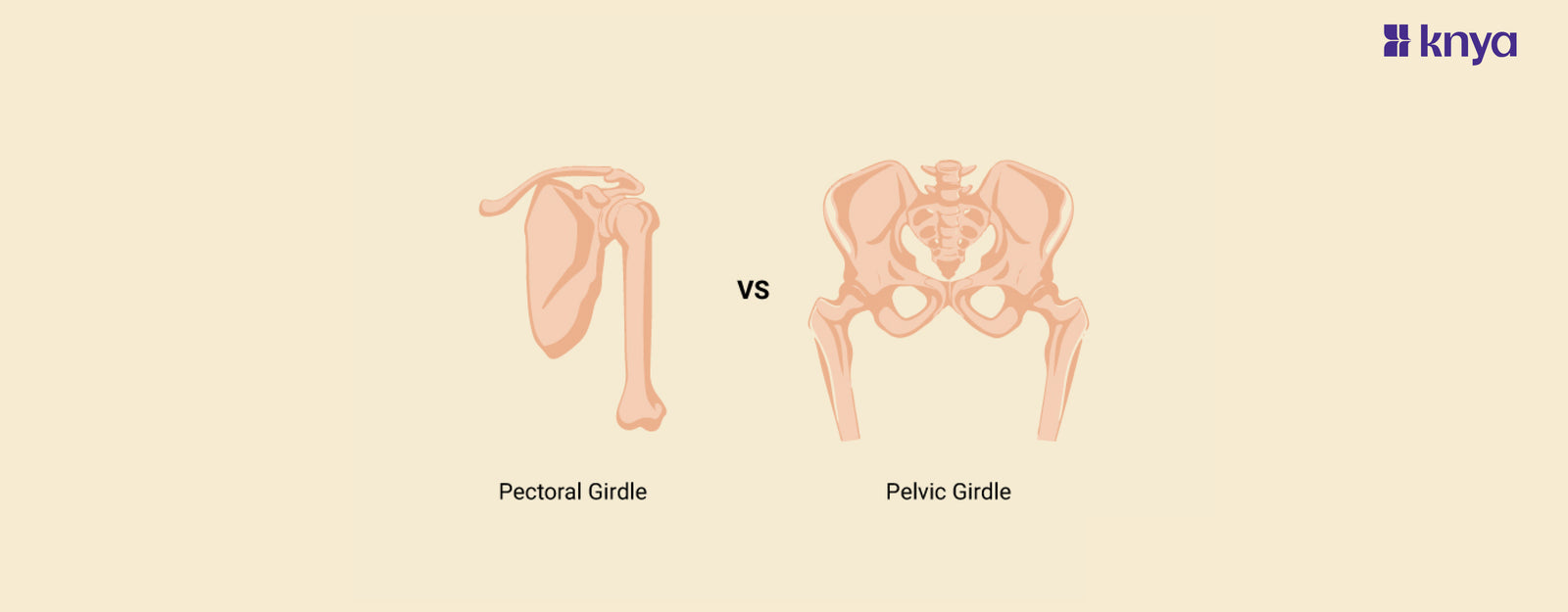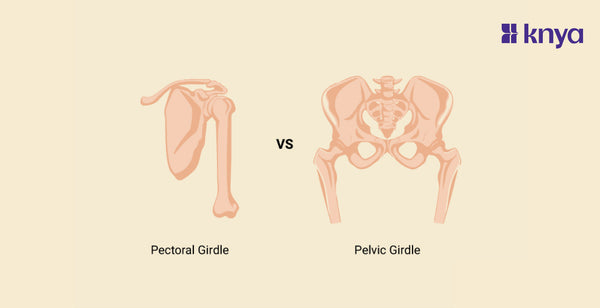Difference Between Pectoral and Pelvic Girdle: The pectoral girdle and pelvic girdle are two essential skeletal structures that play distinctive roles in the human body, providing support and facilitating movement. These girdles serve as points of attachment for the limbs and contribute to the overall stability and flexibility of the body. Here's a brief overview with key differences presented in bullet points:
Difference Between Pectoral and Pelvic Girdle
Here's a concise table highlighting the key differences between the pectoral and pelvic girdles:
|
Characteristic |
Pectoral Girdle |
Pelvic Girdle |
|
Location |
Upper region of the body |
Lower region of the body |
|
Components |
Scapula (shoulder blade) and clavicle (collarbone) |
Two hip bones (ossa coxae) fused anteriorly at the pubic symphysis |
|
Attachment to Axial Skeleton |
Sternoclavicular joint |
Sacroiliac joints, connecting to the sacrum |
|
Function |
Supports and allows a wide range of motion for the upper limbs (arms) |
Supports body weight, and provides stability for lower limbs (legs) |
|
Shape and Mobility |
More open and mobile structure |
More closed and robust structure, emphasizing stability |
|
Muscle Attachment |
Various muscles, including those of the chest, upper back, and arms |
Attachment points for muscles of the lower back, abdomen, and lower limbs |
|
Sexual Dimorphism |
Generally exhibits less sexual dimorphism |
Displays more pronounced sexual dimorphism, with structural adaptations related to childbirth in females |
What is a Pectoral Girdle?
The pectoral girdle, also known as the shoulder girdle, is a set of bones in the human body that forms the skeletal framework for the upper limbs (arms). It consists of two main components: the scapula (shoulder blade) and the clavicle (collarbone). The pectoral girdle is crucial for the attachment and movement of the arms, providing a connection between the axial skeleton (the spine) and the upper limbs.
Key Components of the Pectoral Girdle:
- Scapula (Shoulder Blade):
- Location: The scapula is a flat, triangular-shaped bone located on the posterior side of the upper thorax.
- Attachment: It connects to the clavicle at the acromioclavicular joint and articulates with the humerus (upper arm bone) at the glenohumeral joint.
- Function: The scapula provides a point of attachment for muscles involved in the movement of the arms, especially during activities like reaching, pushing, and pulling.
- Clavicle (Collarbone):
- Location: The clavicle is a long, S-shaped bone that extends horizontally across the front of the neck and upper chest.
- Attachment: It articulates with the sternum (breastbone) medially and the acromion process of the scapula laterally.
- Function: The clavicle acts as a strut, supporting the shoulder and allowing for a wide range of arm movements. It also provides a stable base for the scapula.
Functions of the Pectoral Girdle:
- Mobility: The pectoral girdle allows for a wide range of movements in the arms, providing flexibility for actions such as reaching, lifting, and throwing.
- Muscle Attachment: Muscles that control the movements of the arms attach to the scapula and clavicle, enabling coordinated upper limb actions.
- Support: The pectoral girdle supports the weight of the upper limbs and facilitates their positioning in space.
- Transmission of Forces: Forces generated by the muscles of the upper limbs are transmitted through the pectoral girdle, contributing to activities involving the arms.
The pectoral girdle, along with the muscles and joints associated with it, plays a critical role in the overall function and mobility of the upper limbs, making it an essential component of the human skeletal system.
What is a Pelvic Girdle?
The pelvic girdle is a bony structure in the human body that forms the foundation for the lower limbs (legs). It consists of two hip bones, also known as innominate or pelvic bones, which are fused anteriorly at the pubic symphysis. The pelvic girdle is a vital component of the axial skeleton, providing support to the body's weight and facilitating various movements of the lower limbs.
Key Components of the Pelvic Girdle:
- Hip Bones (Innominate Bones):
- Location: The hip bones are large, irregularly shaped bones located on either side of the pelvis.
- Parts: Each hip bone is composed of three parts—ilium, ischium, and pubis—that fuse during development.
- Attachment: The hip bones articulate with each other at the pubic symphysis anteriorly and with the sacrum posteriorly at the sacroiliac joints.
- Function: The hip bones provide a stable base for the attachment of the lower limbs and support the body's weight. They also protect internal pelvic organs.
Functions of the Pelvic Girdle:
- Support and Stability:
- The pelvic girdle supports the weight of the body and provides a stable foundation for the vertebral column above and the lower limbs below.
- It helps distribute the body's weight evenly to maintain balance during various activities, including standing and walking.
- Attachment for Muscles:
- Muscles of the lower back, abdomen, and lower limbs attach to the pelvic girdle.
- These muscles play a crucial role in maintaining posture, supporting movement, and contributing to activities such as walking and running.
- Protection of Organs:
- The pelvic girdle protects internal pelvic organs, including the reproductive and digestive organs, from external forces and impacts.
- Childbirth:
- The female pelvis, in particular, is adapted for childbirth. The broader pelvic inlet and outlet provide enough space for the passage of the baby during delivery.
- Mobility:
- While the pelvic girdle provides stability, it also allows for a degree of mobility. The pelvis can tilt and rotate, contributing to movements such as walking and turning.
The pelvic girdle is a key structure in the human skeletal system, serving both supportive and dynamic functions. Its anatomy and adaptations reflect the diverse roles it plays in maintaining posture, supporting the body's weight, and facilitating various movements of the lower limbs.
Similarity Between Pectoral and Pelvic Girdle
While the pectoral girdle (shoulder girdle) and pelvic girdle are anatomically distinct and serve different functions in the human body, there are some similarities between the two:
- Bilateral Symmetry:
- Both the pectoral girdle and pelvic girdle are bilateral structures, meaning there is a left and a right component. This symmetry is essential for balanced support and movement on both sides of the body.
- Attachment to Axial Skeleton:
- Both girdles are connected to the axial skeleton.
- The pectoral girdle attaches to the axial skeleton via the sternoclavicular joint and the acromioclavicular joint.
- The pelvic girdle attaches to the axial skeleton at the sacroiliac joints, where the hip bones articulate with the sacrum.
- Articulation with Limbs:
- Both girdles articulate with the limbs and play a crucial role in limb movements.
- The pectoral girdle articulates with the upper limbs (arms) and facilitates a wide range of movements, including those involved in reaching, pushing, and pulling.
- The pelvic girdle supports and articulates with the lower limbs (legs) and is involved in movements such as walking and running.
- Stability and Support:
- Both girdles provide stability and support for the limbs.
- The pectoral girdle supports the weight of the upper limbs and facilitates their movement.
- The pelvic girdle supports the weight of the body and provides a stable foundation for the lower limbs.
- Attachment for Muscles:
- Muscles attach to both girdles, influencing movement and stability.
- In the pectoral girdle, muscles such as those of the chest and upper back attach to the scapula and clavicle.
- In the pelvic girdle, muscles of the lower back, abdomen, and lower limbs attach to the hip bones.
Despite these similarities, it's important to note that the pectoral girdle and pelvic girdle have unique characteristics and functions tailored to their respective roles in the body. The pectoral girdle is associated with the upper limbs and upper body movements, while the pelvic girdle is associated with the lower limbs and supports the body's weight and movement.
|
Check out More Articles |
|















